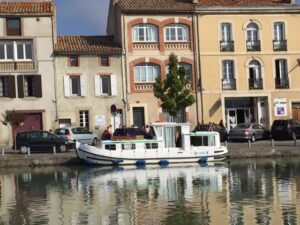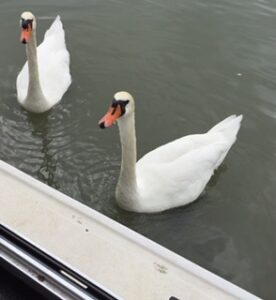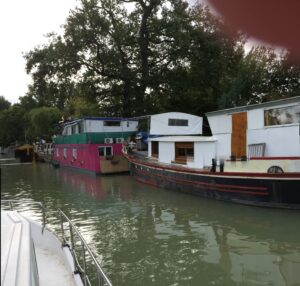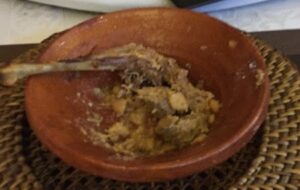Figuring the rental vessel was smaller than our own boat, we’d be on a protected canal with handy banks, and had booked a leisurely eleven-day cruise schedule perfect for meandering—which is our style—through the pastoral French countryside, it’d be a piece of gâteau. Also, I was fluent in French forty years ago; it’d come right back n’est-ce pas?
NO BOATING EXPERIENCE NECESSARY, touted the brochures. Photos of boats fortified with enough fenders to qualify them as aquatic bumper cars raised a soupçon of concern, but we booked our trip on the historic canal anyhow.Built as a trade route between 1666 and 1681, the 241 km Canal du Midi connects the Atlantic Ocean to the Mediterranean, and since it covers altitudes from sea level to 620 feet, there are locks. Lots of locks.
This lock thing was the reason we opted on a one-way trip and added four days to the charter company’s suggested one-week agenda. As it turned out, we were right to do so.
Day 1: There wasn’t so much as a boulangerie near our departure base, but we had a rental car so we drove a few miles to a SuperU and loaded enough provisions for a cruise ship, so we were all set to enjoy our anniversary dinner in style.
Day 2: Mad Dog, armed with a French/English translation program, and notes I’d written for taxi drivers and train station operators (my French had indeed returned very quickly), dropped off the car at our final port and successfully returned by rail. Our plan was to shove off that afternoon, but a howling wind nixed that.
Day 3. With only five kilometers to the first set of locks that opened at nine, there was no urgency to leave early. Besides, it was still blowing a good fifteen knots. We shoved off at nine.
And again at 9:15.
And again at 9:30.
The boat simply refused to go where we wanted to; the minute we weren’t headed with the wind, or into it, we turned sideways and sailed broadside down the canal.TIP: When driving a single-engine boat with lousy steering, ram the bank (this where all those bumpers come in handy), put it into forward gear and give it gas. It will turn; maybe not the way you want to turn, but it will turn. We later learned those fenders were not so much because of Kamakazi drivers—although we encountered a few—but protection from ancient stone walls lining locks, and bank-rammers like us.
Fortified with pain au chocolat and coffee, we steeled ourselves for those first locks, but a very friendly eclusier (lock keeper) helped with our lines while complaining about too many commercials on US television when he live-streamed NASCAR races. By the time we got through the next five locks, we were pros. We made a grand 15 kms that day to the modern facility at Port-Lauragais. We soon learned that this type of marina—one with water, electricity, nearby stores and restaurants—was a rarity.
Days 4/5: After nine fairly daunting locks, we arrived at what proved our favorite stop on our route: Castelnaudary. Dating back to 1103, the self-proclaimed “World Capitol of Cassoulet”—a thick stew made with cannellini beans, duck, duck fat, salt pork, and garlic sausage that tastes much better that it sounds—is everything one expects while cruising a canal in France.We walked the historic streets, stocked the larder with culinary delights, and enjoyed the dockside cafes. Mad Dog felt very French strolling the cobble stoned streets with our daily baguette in hand, but balked at the beret I suggested.
Day 6: Reluctant to leave the charming Castlenaudry, we nevertheless conquered 18 locks towards Bram, a village our rental agency literature said was picturesque, with a great restaurant, docks, electricity and water. NOT!
Bram was pretty, with a restaurant we could only gaze at longingly as we motored by; the place was chockablock with boats, some looking as though they hadn’t moved in years.
We “dry camped” a couple of miles later; our boat had no generator, therefore no electricity. No problem, except my aging laptop’s battery wasn’t ready for life off the grid. We ran the engine until after dinner to cut an early October chill, and charged our iPhone (which we were using as a GPS), Kindles, and our rented Wi-Fi hotspot using a cigarette lighter DC plug adapter.
Day 7: Carcassone, a city first fortified by the Romans in 100BC, didn’t hold our interest. After the seemingly deserted small villages we’d passed, seeing so many locals out on a Sunday (maybe because
all the grocery stores and shopping malls are closed?) was a treat, even though the main attraction seemed to be watching the bumper-boat foibles in the locks. This big-ish city wasn’t really why we came to the Canal, so we opted to continue on to Trebes and dry camped again.
Day 8: The further south we traveled, the busier the locks. After covering 46 kms and 22 locks in two days, we’d pulled over to await the opening of the double locks at Ecluse Saint Martin when we had a epiphany: we were tied to a perfectly good dock! No electricity, of course, but we had wine. We spent a lovely evening with nary another boat in sight. Walking into the small village the next morning, we scored coffee and pain au chocolat at the local brasserie, picked up our baguette at the boulangrie, and then breezed through the two locks, all alone.
Day 9: La Redorte, the chart informed us, had full services (hope for my dead computer?) so we tied up in front of a café, where we spotted an electrical box! Now to find the Harbor Master. With a Gaelic shrug, a man sipping wine at the cafe told us the office was closed (as in permanently) but I should talk to
someone at city hall. Walking into the quaint town a half-mile away, I found la Mairie was fermé. We finally learned that yes, there was a possibility of electricity, but I had to go back into town, buy a token to make it work, and the charge was five bucks an hour. Who needs a computer, anyhow?
La Rivessel, the dockside café, was miraculously open for dinner and we finally enjoyed a great French meal. We had been on the canal for an entire week and it was the first restaurant we found open outside of Castlenaudry.
TRIP NOTE: Fermé/Closed seems to be one of the most frequently used words in France. We were surprised to find so many McDonalds in a country known for its great food, but soon figured out why they are packed with locals: THEY. ARE. OPEN!
Day 10: Our next stop was a marina at Homps, ¡et voila! there it was, just as we entered town. As soon as we tied up we were told it was a private marina and we couldn’t stay. “Ces’t tout! (That’s it!),” we declared, and headed for our final port, where a slip and our car awaited. We were a day early, but we were beat and still facing a 600 mile drive through France to Germany: A whole ‘nother story.
FINAL TRIP NOTES:
Would we do it again? Yes, but in a boat with bow thrusters and a generator. What did we learn? Never count on anything being open. Best part of the trip? The sheer beauty of the French countryside, adorned
with castles and ancient ramparts. And baguettes, cheese and wine. Worst part of the trip? Despite the Euro almost equal to the dollar, everything is very expensive.
Except, of course, for baguettes, cheese and wine.






I adore you. You make me laugh. At 70years old, you don’t find much to laugh about. I’ve read over 1,500 novels in the last 7 years. Although I’ve read a lot of books I’ve enjoyed, You, Janet Evanovich and Nelson DeMille are my favorites.
Much love and success to you all.
P.s. I gave up on Janet when she started hiring ghost writers.
I think we were i Haiti at the same time!
I just finished Troubled Sea and happy to say that I have a way to travel without leaving my garden or animals. All your characters have souls for good or evil that ring true and are so believable. The three women were so strong and interesting in their approach to problems. The four main male characters were so intriguing in their approach to the women and solving problems.
You are one of the reasons I have writer’s block and haven’t finished my 6th book….I’d rather read YOURs than write MINE!
I just finished book 13, Just So Wrong. I live vicariously through you my friend. You draw a perfect picture of your surroundings without going on for 10 pages. That drives me nuts with mystery writers. I digress, I’m signing up for your news letter.
I really enjoyed the Texicans too. A little history that I never knew existed. God Bless you dear.
I throughly enjoy your books. Can’t wait for the next one.